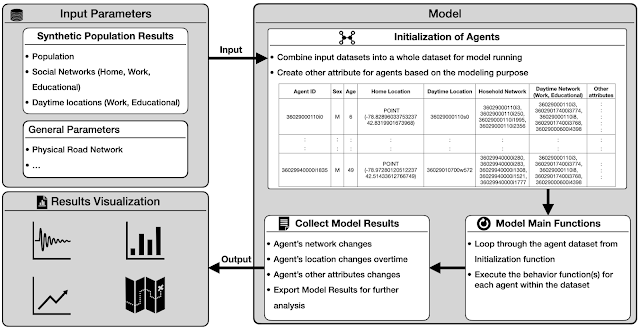Following on from the last post, we (Hossein Amiri, Shiyang Ruan, Joon-Seok Kim, Hyunjee Jin, Hamdi Kavak, Dieter Pfoser, Carola Wenk and Andreas Zufle and myself) have a paper in the Data and Resources track at the 2023 ACM SIGSPATIAL International Conference on Advances in Geographic Information Systems entitled "Massive Trajectory Data Based on Patterns of Life".
This Data and Resources paper introduces readers to a large sets of simulated individual-level trajectory and location-based social network data we have generated from our Urban Life Model (click here to find out more about the model). The data comprises of 4 suburban and urban regions, including 1) the George Mason University Campus area, Fairfax, Virginia, 2) the French Quarter of New Orleans, Louisiana, 3) San Francisco, California, and 4) Atlanta, Georgia. For each of the 4 study regions, we run the simulation with 1K, 3K, 5K, and 10K agents for 15 months of simulation time. We also provide simulations for 10 years and 20 years, having 1K agents for each of the 4 regions of interest. For each dataset, three items are provided: 1) Check-ins, and 2) social network links and 3) trajectory information per agent per five-minute tick. As such we argue in the paper that our datasets are orders of magnitude larger than existing real-world trajectory and location-based social network (LBSN) data sets.
If this sounds of interest we encourage readers to check out the paper (see the bottom of this post), while the datasets, as well as additional documentation, can be found at OSF (https://osf.io/gbhm8/) and the data generator (model) can be found at https://github.com/azufle/pol.
Abstract: Individual human location trajectory and check-in data have been the driving force for human mobility research in recent years. However, existing human mobility datasets are very limited in size and representativeness. For example, one of the largest and most commonly used datasets of individual human location trajectories, GeoLife, captures fewer than two hundred individuals. To help fill this gap, this Data and Resources paper leverages an existing data generator based on fine-grained simulation of individual human patterns of life to produce large-scale trajectory, check-in, and social network data. In this simulation, individual human agents commute between their home and work locations, visit restaurants to eat, and visit recreational sites to meet friends. We provide large datasets of months of simulated trajectories for two example regions in the United States: San Francisco and New Orleans. In addition to making the datasets available, we also provide instructions on how the simulation can be used to re-generate data, thus allowing researchers to generate the data locally without downloading prohibitively large files.
Full Referece:
Amiri, H., Ruan, S., Kim, J., Jin, H., Kavak, H., Crooks, A.T., Pfoser, D., Wenk, C. and Züfle, A. (2023), Massive Trajectory Data Generation using a Patterns of Life Simulation, Proceedings of the 2023 ACM SIGSPATIAL International Conference on Advances in Geographic Information Systems, Hamburg, Germany. (pdf)












